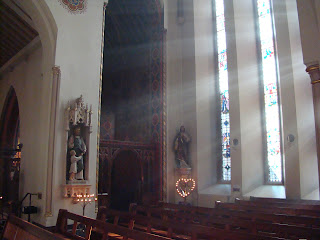Visit to Nottingham
(February 19, 2012)
We headed 15 miles east on a car adventure.
The Caves
The area was originally known as `Tiggua Cobaucc`, meaning ‘place of caves’, and the first reference to Tiggua Cobaucc was in The Life Of King Alfred, by Welsh monk and historian, Asser, the Bishop of Sherborne, who visited Nottingham around 900 AD. The caves were used for housing as early as the 11th century, and troglodytes were certainly recorded in the 17th century. Many were inhabited until 1845, when the St. Mary’s Enclosure Act banned the rental of cellars and caves as homes for the poor, though the practice continued.
 |
| A tannery in the caves |
 | ||
| The rock is sandstone - makes for roomy walking
Nottingham Castle
The Castle Grounds |
Looking out from the Castle
Cathedral Church of St Barnabas
Constructed in 1844. Neat sunlight coming in through the stained glass when we were there. St Joseph statue on the left and the Sacred Heart statue is to the right. Haze was incense from the last ceremony.









No comments:
Post a Comment